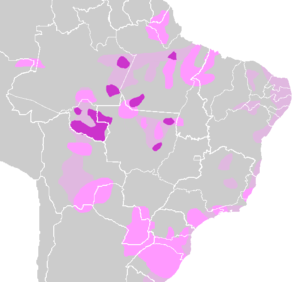Tupian language
| Tupian | |
|---|---|
| Ethnicity | Tupí |
| Geographic distribution |
Brazil, Bolivia, Paraguay, Uruguay, and North-East Argentina |
| Linguistic classification |
Je–Tupi–Carib?
|
| Proto-language | Proto-Tupian |
| Subdivisions | |
| ISO 639-2 / 5 | |
| Glottolog | tupi1275 |

Tupi–Guarani (medium pink), other Tupian (violet), and probable range ca. 1500 (pink-grey)
|
|
The Tupi or Tupian language family comprises some 70 languages spoken in South America, of which the best known are Tupi proper and Guarani.
Rodrigues (2007) considers the Proto-Tupian urheimat to be somewhere between the Guaporé and Aripuanã rivers, in the Madeira River basin. Much of this area corresponds to the modern-day state of Rondônia, Brazil. 5 of the 10 Tupian branches are found in this area, as well as some Tupi–Guarani languages (especially Kawahíb), making it the probable urheimat of these languages and maybe of its speaking peoples. Rodrigues believes the Proto-Tupian language dates back to around 5,000 B.P.
When the Portuguese arrived in Brazil, they found that wherever they went along the vast coast of this newly discovered land, most natives spoke similar languages. Jesuit missionaries took advantage of these similarities, systematizing common standards then named línguas gerais ("general languages"), which were spoken in that region until the 19th century. The best known and most widely spoken of these languages was Old Tupi, a modern descendent of which is still used today by indigenous peoples around the Rio Negro region, where it is known as Nheengatu ([ɲɛʔẽŋaˈtu]), or the "good language". However, the Tupi family also comprises other languages.
...
Wikipedia
